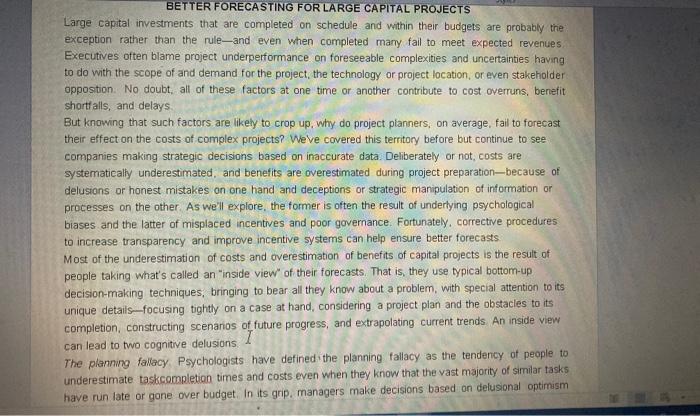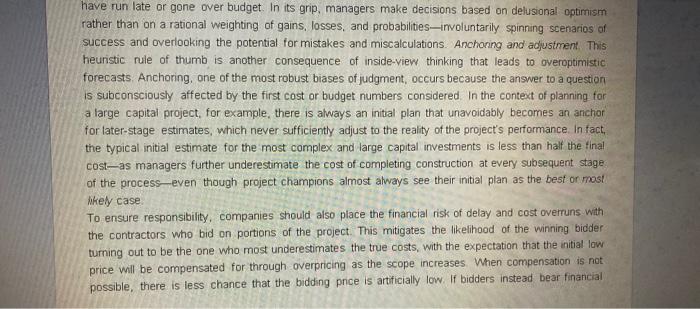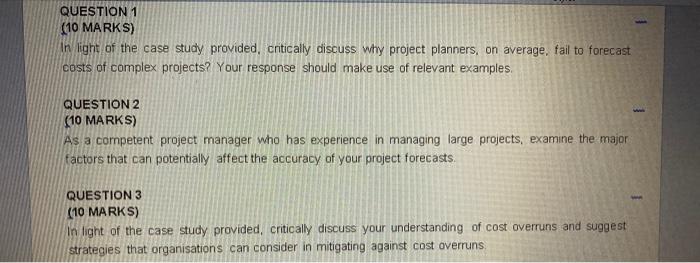BETTER FORECASTING FORLARGE CAPITAL PROJECTS Large capital investments that are completed on schedule and within their budgets are probably the exception rather than the rule-and even when completed many fail to meet expected revenues Executives often blame project underperformance on foreseeable complexities and uncertainties having to do with the scope of and demand for the project, the technology or project location, or even stakeholder oppostion. No doubt, all of these factors at one time or another contribute to cost overruns, benefit shortfalls, and delays But knowing that such factors are likely to crop up, why do project planners, on average, fail to forecast their effect on the costs of complex projects? Weve covered this territory before but continue to see companies making strategic decisions based on inaccurate data. Deliberately or not, costs are systematically underestimated, and benefits are overestimated during project preparation-because of delusions or honest mistakes on one hand and deceptions or strategic manipulation of information or processes on the other. As we'l explore, the former is often the result of underlying psychological biases and the latter of misplaced incentives and poor governance. Fortunately, corrective procedures to increase transparency and improve incentive systems can help ensure better forecasts Most of the underestimation of costs and overestimation of benefits of capital projects is the result of people taking what's called an "inside view" of their forecasts. That is, they use typical bottom-up decision-making techniques, bringing to bear all they know about a problem, with special attention to its unique details-focusing tightly on a case at hand, considering a project plan and the obstacles to its completion, constructing scenarios of future progress, and extrapolating current trends An inside view can lead to two cognitive delusions The planning fallacy. Psychologists have defined the planning fallacy as the tendency of people to underestimate taskcompletion times and costs even when they know that the vast majority of similar tasks have run late or gone over budget. In its grip. managers make decisions based on delusional optimism have run late or gone over budget. In its grip, managers make decisions based on delusional optimism rather than on a rational weighting of gains, losses, and probabilites-involuntarily spinning scenarios of success and overlooking the potential for mistakes and miscalculations. Anchoring and adustment. This heuristic rule of thumb is another consequence of inside-view thinking that leads to overoptimistic forecasts. Anchoring, one of the most robust biases of judgment, occurs because the answer to a question is subconsciously affected by the first cost or budget numbers considered. In the context of planning for a large capital project, for example, there is always an initial plan that unavoidably becomes an anchor for later-stage estimates, which never sufficiently adjust to the reality of the project's performance. In fact, the typical initial estimate for the most complex and large capital investments is less than half the final cost-as managers further underestimate the cost of completing construction at every subsequent stage of the process - even though project champions almost always see their initial plan as the best or most Whely case. To ensure responsibility, companies should also place the financial risk of delay and cost ovemuns wath the contractors who bid on portions of the project. This mitigates the likelihood of the winning bidder turning out to be the one who most underestimates the true costs, with the expectation that the initial low price will be compensated for through overpricing as the scope increases When compensation is not possible, there is less chance that the bidding price is artificially low. If bidders instead bear financial penalties for cost overuns or for being late, then they have incentive to disciose information that they wouldn't otherwise have shared. In our experience, even these minimal incentives are often not in place (10 MARKS) In light of the case study provided, critically discuss why project planners, on average, fail to forecast costs of complex projects? Your response should make use of relevant examples. QUESTION 2 (10 MARKS) As a competent project manager who has experience in managing large projects, examine the major factors that can potentially affect the accuracy of your project forecasts. QUESTION 3 (10 MARKS) in light of the case study provided, critically discuss your understanding of cost overruns and suggest strategies that organisations can consider in mitigating against cost overruns










